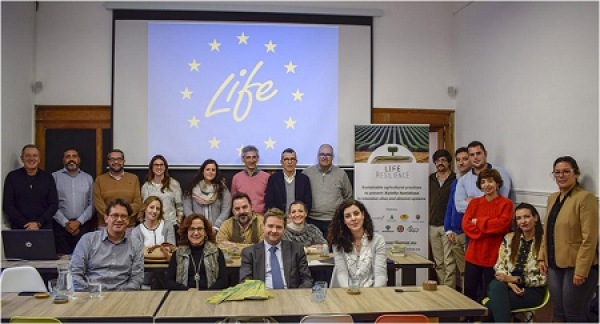In 2013, the first olive tree infected by Xylella fastidiosa was detected in southern Italy, and the alarm was sounded: century-old olive trees began to decay, en masse. Historically, this bacterium had affected vines, almond and cherry trees, and other species of the genus Prunus. Ignorance of how it affected olive trees, together with the economic importance of this crop in the Mediterranean world, had the olive-growing countries very concerned. Drastic containment measures, based on felling all the plants located 100 meters around an infected one, to prevent the spread, produced a scenario of devastation triggering calls for immediate action.
Against this backdrop, the LIFE Resilience project came about, coordinated by the company Galpagro, in cooperation with the 'Genetic resources and olive tree improvement' research group at the Unit of Excellence “María de Maeztu” - Department of Agronomy of University of Cordoba (DAUCO), led by Professor of Plant Production Diego Barranco. The project's main objective is to develop ecosystems for woody crops that are resistant to infection by the Xylella fastiodsa bacterium through sustainable practices and the development of new olive varieties resistant to it.
To achieve these objectives, first of all, we must know how the bacteria behaves. Although its behaviour is still being characterised, it is known that this bacterium has many asymptomatic hosts (plants where it imbeds, but which do not exhibit symptoms), including wild and ornamental species, making it difficult to detect and control. In addition, it needs a vector; that is, an insect extracts the pathogen from an infected plant and transports it to the healthy plant, infecting it. This, coupled with the adaptation of the bacteria to temperate climates, such as southern Italy, is what triggered the catastrophe: a large population of the vector, host plants, a temperate climate, and a very virulent strain.
Averting a scenario like the Italian one, the olive groves of the Mediterranean could be made safer in the event of a possible Xylella outbreak. To this end, LIFE Resilience research teams are working on the inclusion of plant cover attracting fauna that will control the vector insect, increasing the biodiversity of the olive grove while maintaining population balance, at the same time. Work is also being done on irrigation deficit strategies, and to decrease carbon footprints, pursuing intensive olive groves that are less extractive and more sustainable.
On the Cordoban team researchers Concepcion Muñoz and Pedro Valverde are working on the genetic improvement of olive trees through the creation of new strains resistant to bacteria. After identifying resistant varieties in the infected Italian zone, such as Leccino and Fs-17,crosses have been made between these varieties, and others with good agronomic characteristics, since the producers, in addition to resistance to Xylella , are interested in the olive grove's yield and production being robust and manageable.
Experience in genetic improvement, having seedling germination protocols, cultivation in greenhouses, and a selection process fine-tuned by the UCO group, is what has made the project's progress possible. In fact, prior to the start of the project, the research group had already carried out the first crosses in search of strains resistant to Xylella, which were planted at 'El Valenciano', the project's main experimental farm, of the company Galpagro.
First, tests will be carried out on a selection of pilot plots in Spain, Italy and Portugal, in order to replicate the most successful ones on a larger number of plots, thus employing a dual filter.
The UCO group has signed an agreement with growers in the Italian area to send the genotypes to the infected scenario in order to gauge whether they are resistant to the pathogen, bringing a solution to apocalyptic infection scenariosone step closer.
Jueves, 06 Febrero 2020 08:20
The Objective: Olive Trees More Resistant to Xylella
The LIFE Resilience project establishes sustainable management practices and develops olive genotypes resistant to this bacteria, which is inflicting massive economic damage in Europe
Publicado en
Nature science


